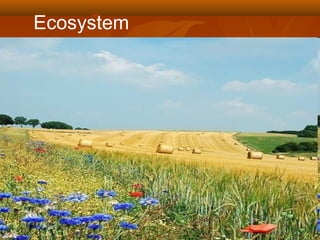
Ecosystem
- 1. Ecosystem
- 2. History of Ecosystem The term ecosystem first appeared in a 1935 publication by the British ecologist Arthur Tansley (1935). However, the term had been coined already in 1930 by Tansley's colleague Roy Clapham. Tansley (1939) expanded on the term in his later work, adding the Ecotope concept to define the spatial context of ecosystems
- 3. According to woodbury (1954) Ecosystem is a complex in which habitat, plants and animals are considered as one interesting unit, the materials and energy of one passing in and out of the others. According to E.P. Odum, the ecosystem is the basic functional unit of organisms and their environment interaction with each other and with their own components. e.g. One square meter of grassland, a large lake, a large tract of forest, balanced aquarium, a certain area of river and ocean. All the ecosystems of the earth are connected to one another, like, river ecosystem is connected with the ecosystem of ocean, and a small ecosystem of dead logs is a part of large ecosystem of a forest. A complete self-sufficient ecosystem is rarely found in nature but situations approaching self-sufficiency may occur.
- 4. Structure of Ecosystem The structure of an ecosystem is basically a description of the organisms and physical features of environment including the amount and distribution of nutrients in a particular habitat. From the structure point of view, all ecosystems consist of the following basic components: 1. Abiotic components 2. Biotic components
- 5. Abiotic Components: An ecosystem possesses both biotic (living) and abiotic non-living components. The abiotic components include soil, water, light, inorganic nutrients and weather Biotic Components: The biotic components of the ecosystem can be categorized as either producers or consumers. Producers are autotrophic organisms with the capability of carrying out photosynthesis and making food for themselves, and indirectly for the other organisms as well. In terrestrial ecosystems the producers are predominantly green plants, while in freshwater and marine ecosystems the dominant producers are various species of algae.
- 6. Biotic components The biotic components include all living organisms present in the environmental system. From nutrition point of view, the biotic components can be grouped into three basic components: 1. Producer 2. Consumers and 3. Decomposers or reducers and transformers
- 7. 1. Producers The producers are the autotrophic elements –chiefly green plants. They use radiant energy of sun in photosynthetic process whereby carbon dioxide is assimilated and the light energy is converted into chemical energy. The chemical energy is actually locked up in the energy rich carbon compounds. Oxygen is evolved as byproduct in the photosynthesis. This is used in respiration by all living things. Algae and other hydrophytes of a pond, grasses of the field, trees of the forests are examples of producer. Chemosynthetic bacteria and carotenoid bearing purple bacteria that also assimilate carbon-dioxide with the energy of sunlight but only in the presence of organic compounds also belong to this category.
- 8. 2. Consumer Those living members of ecosystem which consume the food synthesized by producers are called consumers. Under this category are included all kinds of animals that are found in an ecosystem. There are different classes or categories of consumers that are discussed in following. Primary consumers: Those are dependent on producers or green plants for their food called primary consumers (purely herbivorous). e.g. Insects rodents rabbit, cow, goat for terrestrial ecosystem. On the other hands crustaceans, molluscs etc. for aquatic habitat. According to Elton, 1939 primary consumers are the “Key industry animals” in a particular ecosystem.
- 9. Secondary consumers: Those animals are adapted to consume herbivores as well as plants as their food called secondary consumers. They are carnivores and omnivores. e.g. sparrow, crow, fox etc. Tertiary consumers: These are the top carnivores which prey upon secondary consumers as well as other carnivores, omnivores and herbivores. Lions, tigers hawk, vulture etc. are considered as tertiary or top consumers. Parasites, scavengers and saprobes: They are consumers. The parasitic plants and animals utilize the living tissues of different plants and animals. The scavengers and saprobes utilize dead remains of animals and plants as their food.
- 11. 3. Decomposers and transformers Decomposers attack the dead remains of producers and consumers and degrade the complex organic substances into simpler compounds. The simple organic matters are then attacked by another kind of bacteria, the transformers which change these organic compounds in to the inorganic forms that are suitable for reuse by producers of green plants. The decomposers and transformers play very important role in maintaining the dynamic nature of ecosystems.
- 12. Function of Ecosystem Action of biotic and abiotic components with the help of solar energy through the ecosystem is called function of ecosystem. In any ecosystem we have the following functional components; 1. Inorganic constituents (air, water and mineral salts) 2. Organisms (plants, animals and microbes) and 3. Energy input which enters from outside ( the sun)
- 13. The principal steps in the operation of ecosystem Thus the principal steps in the operation of ecosystem are as follows: 1. Reception of radiant energy of sun. 2. Manufacture of organic materials from inorganic ones by producers, 3. Consumption of producers by consumers and further elaboration of consumed materials and 4. After the death of producers and consumers, complex organic compounds are degraded and finally converted by decomposers and converters into such forms as are suitable for reutilization by producers.
- 14. Solar energy producer primary consumers primary carnivores dead remains secondary carnivores Raw materials decomposers Flow of energy at different levels of ecosystem.
- 15. SolarAenergy B producer primary consumers primary carnivores dead remains secondary C carnivores Raw materials D decomposers Flow of energy at different levels of ecosystem.
